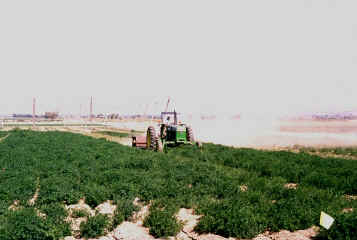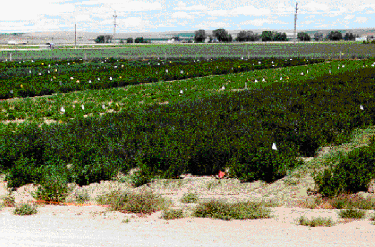![]()
Pollinator Paradise Parma R & E Center
PSES
College of Agriculture
University of Idaho
Research slide shows
Bee management
Philosophy
Links
Contact us
![]()
Pollination Ecology
|

Clipping a research field in May |
| Why clip?
photos: |
This project was funded by a USDA PIAP grant, and by a USDA Cooperative Agreement with the Bee Biology and Systematics Laboratory in Utah. It anticipates the need for the Pollination Ecology program to become involved in more pesticide testing as current extension personnel retire, and as the impact of Food Quality Protection Act reduces options for lygus control. The project also builds on my research on changes in floral resources and on the prediction that releasing bees early in bloom will maximize pollination. The study examines the net impact of a cultural control: "clipping" (mowing) alfalfa seed fields early in the season to synchronize bloom with expected bee release. If timed well, this practice could result in more cross-pollination, and higher seed yields. Appropriate timing might also reduce lygus bugs long enough to delay pesticide application by a week or two, allowing for more pollination with less risk of bee mortality. However, clipping may cause the plant to use more carbohydrate reserves in the crown, leaving less for developing flowers and pods. |
 |
Clipped strips in research field in early June.
Flags indicate insecticide plots. Photo by Takuji Noma Nested in the clipping treatments are different combinations of early- and late-season pesticide treatments. The goal was to determine whether it is more effective to use a pyrethroid to reduce lygus populations before or after bees are released. |
|
Resistance to pyrethroids develops rapidly, so they should be used only once per season if possible. However, the timing of their use has not been examined in conventional pesticide testing. The results showed that lygus bug could indeed be reduced early in the season by clipping. More importantly however, lygus bug increased in strips clipped shortly before bee release relative to strips clipped early in the season, and strips not clipped. This suggests that clipping a strip along one edge of the alfalfa field before bee release might create a "trap crop" late in the season. Lygus bug and other bud and flower pests would move to the trap strip, and away from developing seed pods. The trap strip could be treated with insecticide at a much reduced cost compared with the entire field. This could be a particularly useful strategy for fields that are adjacent to crops such as hay fields, or range lands that harbor lygus bug populations, if the clipped strip is created adjacent to the source of lygus immigration. The clipped strip might also provide additional pollen and nectar resources for the bees at a time when little is available in the main field. |
 |
Clipped strips in research field in early July. By August, the late clipped strip was in full bloom while the early clipped
strip was setting seed.
Photo by Takuji Noma |
![]()
Top of page Pollinator Paradise
Parma R & E Center
PSES College of Agriculture
University of Idaho
Research slide shows
Bee management
Philosophy
Links
Contact us
![]()
Revised August 6, 2000.
Copyright © 2000, Karen
Strickler and Takuji Noma. All rights reserved.